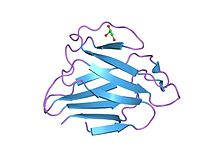Intermediate filaments
| Intermediate filament tail domain | |||||||||
|---|---|---|---|---|---|---|---|---|---|

structure of lamin a/c globular domain
|
|||||||||
| Identifiers | |||||||||
| Symbol | IF_tail | ||||||||
| Pfam | PF00932 | ||||||||
| InterPro | IPR001322 | ||||||||
| PROSITE | PDOC00198 | ||||||||
| SCOP | 1ivt | ||||||||
| SUPERFAMILY | 1ivt | ||||||||
|
|||||||||
| Available protein structures: | |
|---|---|
| Pfam | structures |
| PDB | RCSB PDB; PDBe; PDBj |
| PDBsum | structure summary |
| Intermediate filament protein | |||||||||
|---|---|---|---|---|---|---|---|---|---|

human vimentin coil 2b fragment (cys2)
|
|||||||||
| Identifiers | |||||||||
| Symbol | Filament | ||||||||
| Pfam | PF00038 | ||||||||
| InterPro | IPR016044 | ||||||||
| PROSITE | PDOC00198 | ||||||||
| SCOP | 1gk7 | ||||||||
| SUPERFAMILY | 1gk7 | ||||||||
|
|||||||||
| Available protein structures: | |
|---|---|
| Pfam | structures |
| PDB | RCSB PDB; PDBe; PDBj |
| PDBsum | structure summary |
| Intermediate filament head (DNA binding) region | |||||||||
|---|---|---|---|---|---|---|---|---|---|
| Identifiers | |||||||||
| Symbol | Filament_head | ||||||||
| Pfam | PF04732 | ||||||||
| InterPro | IPR006821 | ||||||||
| SCOP | 1gk7 | ||||||||
| SUPERFAMILY | 1gk7 | ||||||||
|
|||||||||
| Available protein structures: | |
|---|---|
| Pfam | structures |
| PDB | RCSB PDB; PDBe; PDBj |
| PDBsum | structure summary |
Intermediate filaments (IFs) are cytoskeletal components found in the cells of vertebrate animal species, and perhaps also in other animals, fungi, plants, and unicellular organisms. They are composed of a family of related proteins sharing common structural and sequence features. Initially designated 'intermediate' because their average diameter (10 nm) is between those of narrower microfilaments (actin) and wider myosin filaments found in muscle cells, the diameter of Intermediate filaments is now commonly compared to actin microfilaments (7 nm) and microtubules (25 nm). Most types of intermediate filaments are cytoplasmic, but one type, the lamins, are nuclear.
The structure of proteins that form IF was first predicted by computerized analysis of the amino acid sequence of a human epidermal keratin derived from cloned cDNAs. Analysis of a second keratin sequence revealed that the two types of keratins share only about 30% amino acid sequence homology but share similar patterns of secondary structure domains. As suggested by the first model, all IF proteins appear to have a central alpha-helical rod domain that is composed of four alpha-helical segments (named as 1A, 1B, 2A and 2B) separated by three linker regions.
The N and C-termini of IF proteins are non-alpha-helical regions and show wide variation in their lengths and sequences across IF families. The basic building-block for IFs is a parallel and in-register dimer. The dimer is formed through the interaction of the rod domain to form a coiled coil. Cytoplasmic IF assemble into non-polar unit-length filaments (ULF). Identical ULF associate laterally into staggered, antiparallel, soluble tetramers, which associate head-to-tail into protofilaments that pair up laterally into protofibrils, four of which wind together into an intermediate filament.
Part of the assembly process includes a compaction step, in which ULF tighten and assume a smaller diameter. The reasons for this compaction are not well understood, and IF are routinely observed to have diameters ranging between 6 and 12 nm.
...
Wikipedia
